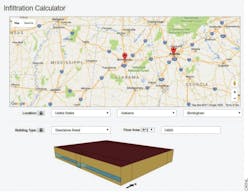Calculate Envelope Air Tightness with New Tool
A new tool developed at Oak Ridge National Laboratory (ORNL) now addresses one of the most overlooked energy issues facing commercial buildings: building envelope air tightness. The laboratory’s new web-based energy savings calculator now offers FMs and other building professionals the ability to see firsthand how envelope improvements might be able to reduce costs in their particular facilities.
The calculator, which was developed in conjunction with the Air Barrier Association of America and the National Institute of Standards and Technology, looks particularly at the practice of introducing air barrier systems into buildings, as air leaks can significantly harm energy efficiency.
“Air leaks are responsible for over 4% of all energy used in the U.S.,” says ORNL’s Som Shrestha. “This energy savings calculator can demonstrate the benefit of constructing airtight buildings.”
The calculator allows users to determine how an air barrier system might improve a building’s energy efficiency by putting in a facility’s general location (based on 52 U.S. cities), building type, floor area, leakage rates and energy costs. It then predicts how much natural gas and electricity the user will be able to reduce and the avoided costs of each.
The U.S. Department of Energy’s Windows and Building Envelope Research and Development Roadmap for Emerging Technologies notes, “Computational tools are critically important for the design of commercial buildings with energy-efficient envelope materials. As new technologies are developed, models and simulation tools must be updated to account for increased performance.”
The calculator was created to fill a void that prevents widespread adoption of air barrier systems into buildings. Because the tool can be used by architects, designers and owners, it can accurately estimate the energy performance of a given air barrier system at any stage for a building.
Try the calculator yourself at airleakage-calc.ornl.gov.
The calculator computes how much you might save in energy costs with an air barrier system. It takes location, building type and size, and leakage rates to determine savings.
